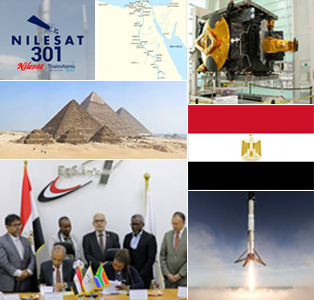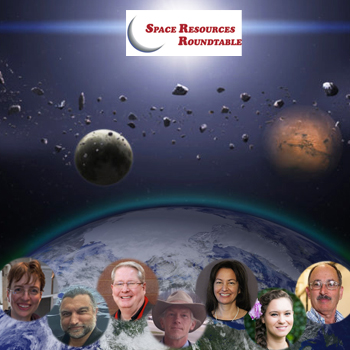Egypt Advancing Satellite Comms, Africa Space Collaboration, Founding ‘Space City’ by End of Year
|
MONDAY☆ Jun 6 — ISS, ~405-km LEO: Expedition 67 seven-member crew to receive CRS-25 Cargo Dragon this week while working with cargo / refuse transfers to Cygnus NG-17, Progress 79, 80, 81; working with muscle biochemical investigation, eye changes studies. ☆ Jun 6 — Tiangong Space Station, ~370-km LEO: Shenzhou 14 to dock to Tianhe nadir port, 3-member crew should be aboard station and transferring cargo from Tianzhou-4, will perform EVAs to integrate TSS systems. Highlights… o NewSpace: SpaceX Starship 24 may be orbital test prototype, Super Heavy B7 being prepped for static fire test; SpaceIL US$100M Beresheet-2 mission with UAE collaboration working toward 2024 landing; Axiom Space and Collins Aerospace to develop next-gen spacesuits under $3.5B NASA contract. ☆ Solar System: Excess / thicker haze of Uranus atmosphere may explain difference in color from Neptune; University of Houston study suggests seasonal solar energy absorption variance as cause of massive Mars dust storms. ☆ Galaxy: Unintentional observations from Japan weather satellite offer data into Betelgeuse dimming; Super-Earth Ross 508 b, discovered with Subaru InfraRed Doppler, shows promise of near-infrared spectroscopy in locating exoplanets. o Global: Policy for ‘SpaceX-like ventures’ in India within next 2 years to be revealed soon; Japan and S Korea to further cooperate with USA in space per recent summits with Biden; Roscosmos Rogozin states 2035 Lunar Research Station agreement with China is nearly complete. ● USA: Boeing Starliner to journey to KSC for data analysis, company preparing for 1st crew mission; JWST preparing to characterize exoplanets 55 Cancri e and LHS 3844 b, thought to rain liquid / solid lava (respectively); NASA orders 5 additional ISS Crew Dragon flights under CCtCap. ● Hawai’i: 2022 Mauna Kea Coin design to feature ‘modern and traditional science’; Peter Wizinowich of Keck to be given AAS award for Astronomical Instrumentation Jan 2023; 43-cm teaching telescope at Waipahu High School is ‘sized-down version’ of upcoming UH Hilo instrument. |
 |
● = Terrestrial events, and…
o = International terrestrial events in local time. ★ = Space events, and… ☆ = International space / astro events in Hawaii Standard Time unless noted. Add 10 hours to obtain UT (‘Universal Time’). |
Weekly Planet Watch – Morning Planets: Venus, Mars, Saturn, Jupiter, Neptune (ESE).
22nd Space Resources Roundtable Convenes ~80 Speakers in 14 Sessions June 7-10
|
☆ Jun 6 — Apollo Asteroid 2022 KB3: Near-Earth Flyby (0.007 AU) ☆ Jun 6 — Aten Asteroid 2021 GT2: Near-Earth Flyby (0.024 AU) Continued From… o Jun 1-10 — United Nations Committee on the Peaceful Uses of Outer Space, Vienna, Austria: 65th Session Committee on the Peaceful Uses of Outer Space (COPUOS). TUESDAY● Jun 7 — NASA, Online / Washington DC: NASA Astrophysics Advisory Committee Meeting; 15:00-17:00 EDT. ● Jun 7-10 — PTMSS, SRR, Colorado School of Mines, Golden CO: Space Resources Roundtable 2022. o Jun 7-10 — LATMOS, ESA, APL, IAS, et al, Orléans, France: Mercury: Current and Future Science of the Innermost Planet. ☆ Jun 7 — Moon: At first quarter, 04:48. ☆ Jun 7 — Amor Asteroid 2022 KV3: Near-Earth Flyby (0.045 AU) WEDNESDAY★ Jun 8 — SpaceX, Launch Falcon 9 / Nilesat 301, SLC-40, Kennedy Space Center FL: Falcon 9 to launch Nilesat 301 geostationary communications satellite, built by Thales Alenia Space; first stage booster to land on a drone ship in Atlantic. ● Jun 8 — American Institute of Aeronautics and Astronautics (AIAA), Online / Reston VA: ASCENDxSummit Webinar: Sustaining Space for the Next Generation; 12:00-14:15. ☆ Jun 8 — Apollo Asteroid 2022 KV1: Near-Earth Flyby (0.028 AU) ☆ Jun 8 — Apollo Asteroid 2018 MZ4: Near-Earth Flyby (0.074 AU) |
THURSDAY
● Jun 9 — Hawaii Business Roundtable, Hawaii Island Economic Development Board, Online / Hilo HI: Webinar: ‘Āina Maunakea: Wherein lies the future? with David Lassner (Univ. of Hawaii), Greg Chun (Maunakea Stewardship Chancellor’s Office), Doug Simons (University of Hawaii IfA; 15:00-17:00 HST.
● Jun 9-12 — American Astronomical Society, US Naval Research Laboratory, NASA, Virginia Tech, Siemens, Praxis, Kratos, Lockheed, MRV Rocketry, Blacksburg VA: 2022 Student CanSat Competition; at Virginia Tech.
☆ Jun 9 — Apollo Asteroid 2018 LU2: Near-Earth Flyby (0.037 AU)
☆ Jun 9 — Apollo Asteroid 2022 KM1: Near-Earth Flyby (0.041 AU)
☆ Jun 9 — Aten Asteroid 2010 MB: Near-Earth Flyby (0.068 AU)
☆ Jun 9 — Apollo Asteroid 2015 LY13: Near-Earth Flyby (0.083 AU)
☆ Jun 9 — Apollo Asteroid 2022 KH3: Near-Earth Flyby (0.092 AU)
FRIDAY
★ Jun 10 — SpaceX, Launch Falcon 9 / Dragon CRS-25, LC-39A, Kennedy Space Center FL: Dragon 2 spacecraft to launch on its 5th cargo resupply mission / 25th mission overall for SpaceX under Commercial Resupply Services contract, launch 10:22 EDT.
● Jun 10 — Apple TV+, Online: For All Mankind will land on Mars when Season 3 premieres.
☆ Jun 10 — Moon: 4.5° NNE of Spica, 02:00.
☆ Jun 10 — Apollo Asteroid 2022 KC3: Near-Earth Flyby (0.016 AU)
SATURDAY
★ Jun 11 — Fermi Gamma-ray Telescope, LEO: Spacecraft with Large Area Telescope & Gamma-ray Burst Monitor instruments reaches 14 full years / enters 15th year in Space; launched 2008.
☆ Jun 11 — Venus: 1.53° SE of Uranus, 14:00.
SUNDAY
☆ Jun 12 — ISS, Dragon CRS-25 Rendezvous and Docking, ~405-km LEO: SpaceX CRS-25 Cargo Dragon to dock with ISS 06:20 EDT, live coverage available.
● Jun 12-16 — American Astronomical Society, Pasadena CA: 240th Meeting of the AAS.
☆ Jun 12 — Apollo Asteroid 2022 GU6: Near-Earth Flyby (0.008 AU)
☆ Jun 12 — Apollo Asteroid 2006 XW4: Near-Earth Flyby (0.015 AU)
☆ Jun 12 — Apollo Asteroid 2022 KC3: Near-Earth Flyby (0.016 AU)
☆ Jun 12 — Amor Asteroid 2022 KQ: Near-Earth Flyby (0.066 AU)
☆ Jun 12 — Apollo Asteroid 2016 VX1: Near-Earth Flyby (0.082 AU)

